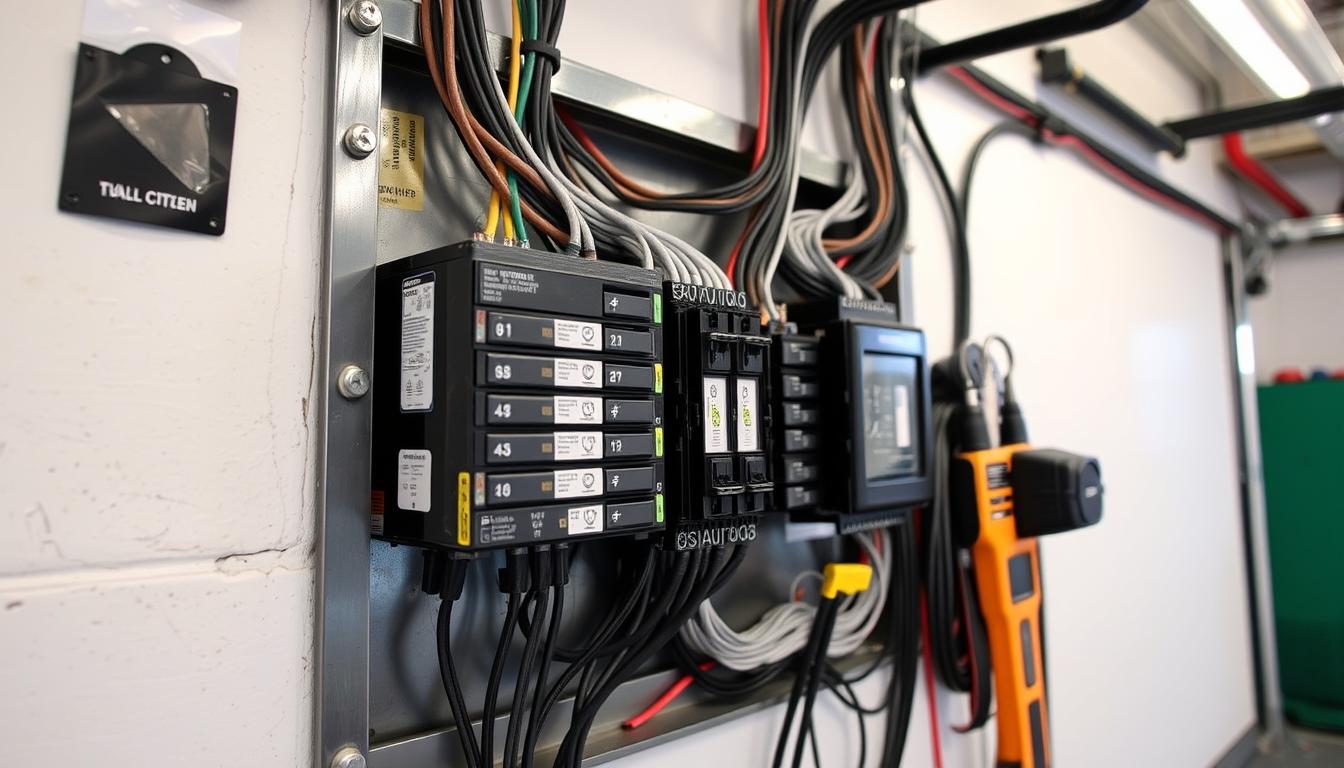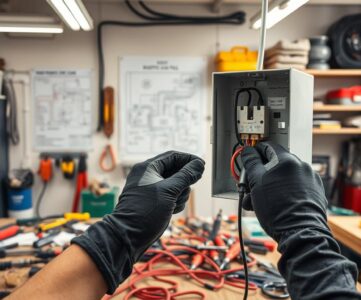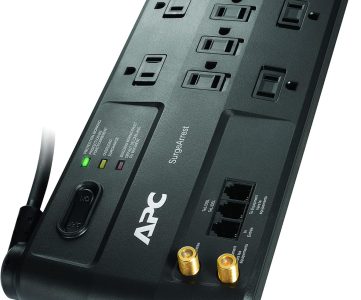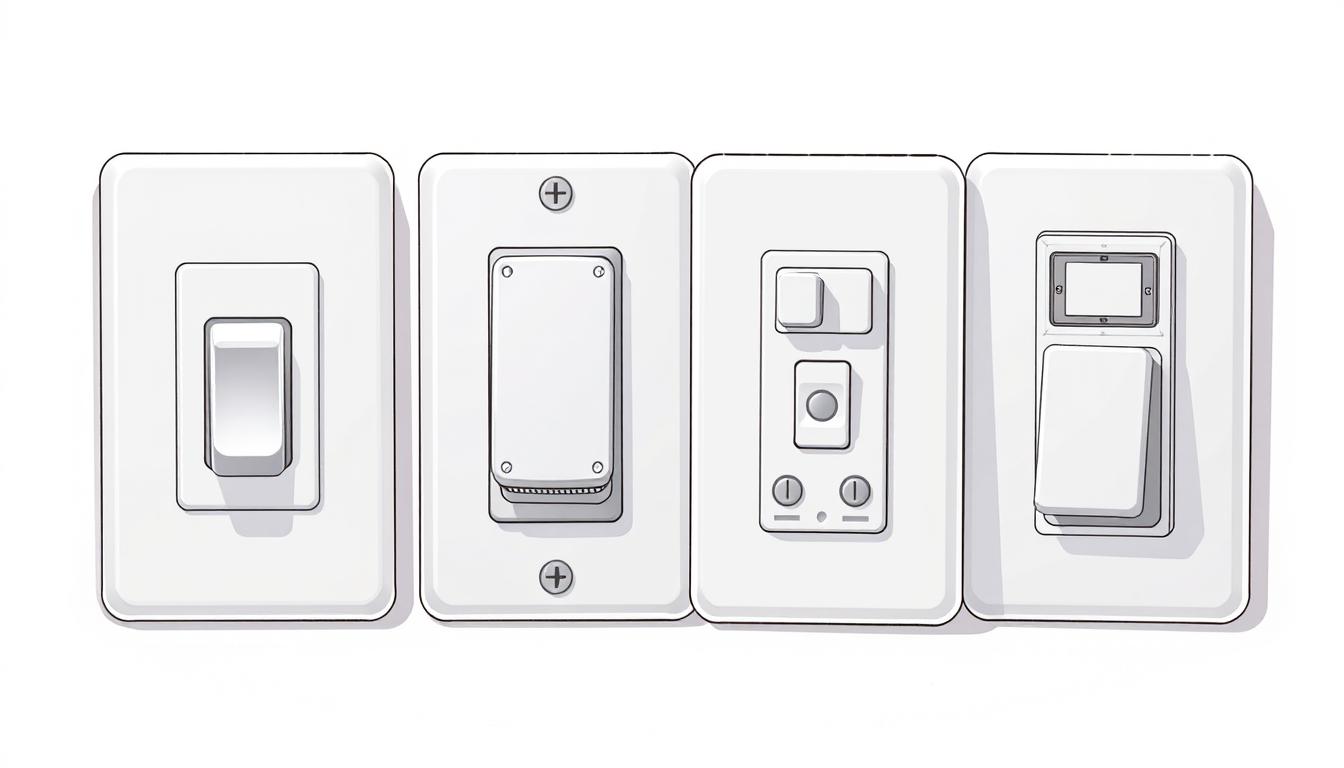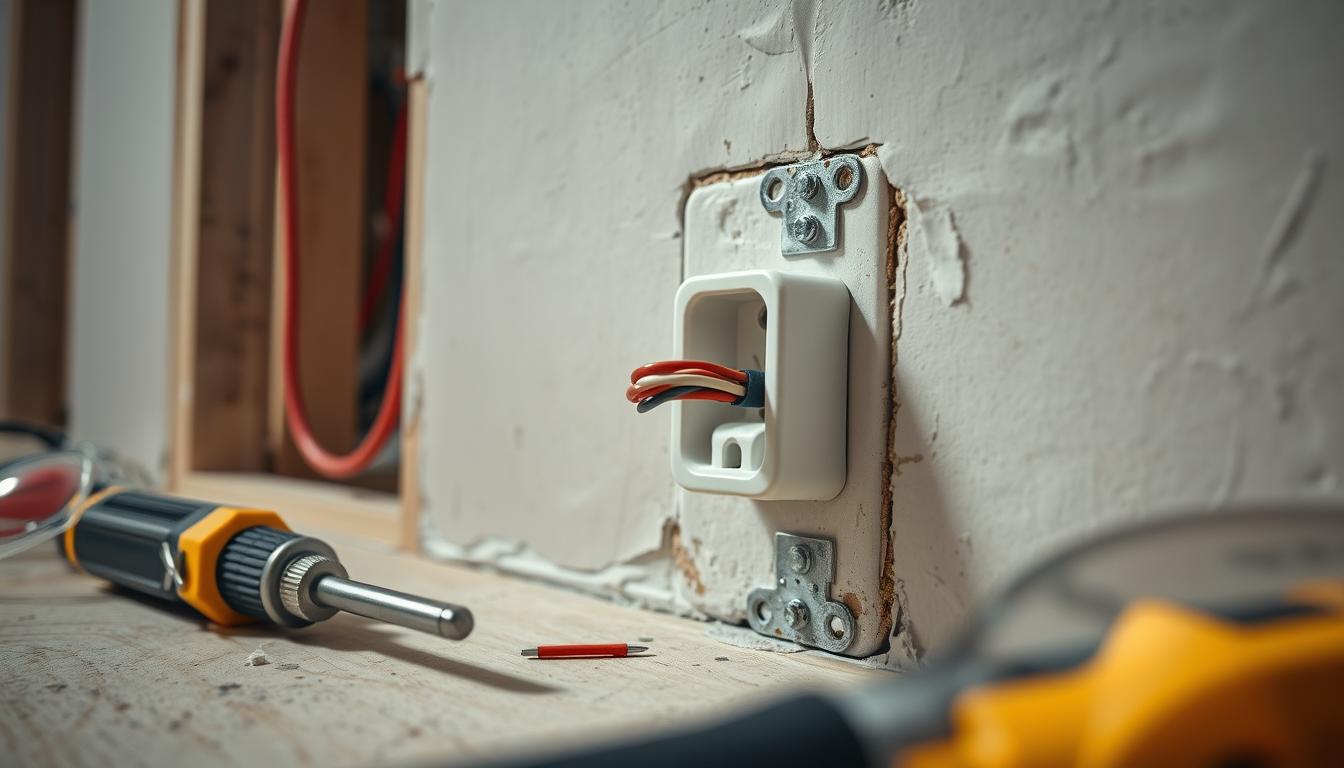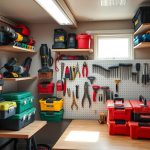Electrical sub panels are key for managing power and expanding circuits. They help homeowners handle electrical loads better. A sub panel is a smart choice for adding new circuits safely and reliably.
Sub panels are vital for safe and efficient electrical systems. They boost electrical capacity, lowering the chance of overload and fires. With the right steps, even those new to electrical work can install a sub panel easily.
Key Takeaways
- Electrical sub panels are essential for power distribution and circuit expansion
- Sub panels provide a safe and reliable way to add new circuits to an existing electrical system
- Installing a sub panel can increase electrical capacity and reduce the risk of overload and electrical fires
- Understanding the basics of electrical sub panels is crucial for safe and efficient electrical system operation
- A well-installed sub panel can provide years of reliable service with proper maintenance
Understanding Electrical Sub Panels and Their Purpose
Electrical sub panels are key in managing electrical loads. They ensure power is distributed safely and efficiently. During an electrical upgrade, they are crucial for adding new circuits and boosting electrical capacity.
A sub panel is a smaller version of the main electrical panel. It sends power to specific areas like garages or basements. Installing a sub panel helps upgrade your electrical system, perfect for homes needing more power.
- Adding new circuits to a home or building
- Increasing electrical capacity during an electrical upgrade
- Providing power to outbuildings, such as garages or sheds
- Supporting high-energy appliances, such as electric vehicles or HVAC systems
Knowing about sub panels helps homeowners make smart choices for their panel installation and electrical upgrade. Whether you need more circuits or power, a sub panel offers a safe and efficient way to meet your needs.
Signs You Need a Sub Panel Installation
Knowing when to install a sub panel is key for a safe and efficient electrical system. Load management is a big factor in deciding if you need a sub panel. Signs like overloaded circuits and often tripped circuit breakers show you might need one.
Other signs you might need a sub panel include:
- Frequent power outages or brownouts
- Not enough power outlets for your needs
- Planning to add new devices or appliances that use more energy
Good load management is vital for handling more energy needs. A sub panel helps spread out the electrical load better. This reduces the chance of overloads and boosts system performance.
Planning Your Sub Panel Installation
Planning a sub panel installation involves several key steps. First, you need to find the right spot for your sub panel. This spot depends on your home or business’s wiring needs and where your main electrical panel is.
Next, you must figure out how much power you’ll need. This means adding up the power needed for all devices and appliances connected to the sub panel. Knowing this helps you choose the right sub panel size and wiring.
Determining the Right Location
Choosing the right spot for your sub panel is crucial. Consider a few things:
- How close it is to the main electrical panel
- If it’s easy to get to for maintenance and repairs
- If it meets local electrical codes and rules
Calculating Power Requirements
To figure out power needs, add up the power for all devices and appliances. This helps pick the right sub panel size and wiring.
Required Tools and Materials
The tools and materials needed vary by job. But, common items include:
- Sub panel enclosure
- Circuit breakers
- Wiring and connectors
- Electrical tape and wire nuts
Permits and Regulations
Before starting, get the needed permits and follow local electrical rules. This ensures a safe and proper installation. It also avoids fines or penalties.
| Permit Type | Description |
|---|---|
| Electrical Permit | Required for all electrical installations, including sub panel installations |
| Building Permit | May be required for sub panel installations that involve structural changes to the building |
Essential Safety Considerations Before Installation
When dealing with electrical installations, safety is a top priority. It’s crucial to think about several key factors before starting. Always turn off the main power supply to avoid accidents or electrical shocks.
Using personal protective equipment, like gloves and safety glasses, is important. It helps protect against potential hazards. Also, make sure the work area has good ventilation. This prevents dust and particles from causing problems during the installation.
Some important installation safety considerations to keep in mind include:
- Verifying the integrity of the electrical panel and its components
- Ensuring all wires and connections are secure and meet local regulations
- Using proper tools and equipment to avoid damage or injury
By focusing on installation safety and taking the right precautions, you can reduce the risk of accidents. This ensures a successful electrical sub panel installation. Remember, a safe and efficient installation is as important as the quality of materials and equipment used.
Types of Sub Panels and Selection Criteria
Choosing the right sub panel is important. It affects power distribution and circuit expansion. The right one ensures safe and efficient electrical supply in buildings.
Deciding between an indoor or outdoor sub panel is key. Indoor panels fit well in homes, while outdoor panels are better for businesses. The choice depends on the building’s needs and location.
Indoor vs Outdoor Panels
Indoor sub panels go inside buildings, like basements. They’re smaller and perfect for homes. Outdoor panels, made for harsh weather, are used in businesses.
Amperage Ratings and Specifications
The sub panel’s amperage rating is crucial. It shows how much current it can handle. Pick a panel that fits your building’s needs and is safe.
Brand Recommendations
Brands like Siemens, Eaton, and Square D make great sub panels. They offer various options to meet your building’s needs. Choosing a reputable brand ensures a safe and efficient electrical system.
| Brand | Amperage Rating | Specifications |
|---|---|---|
| Siemens | 100-400A | Indoor and outdoor options, compatible with existing electrical systems |
| Eaton | 150-600A | High-quality materials, meets all relevant safety standards |
| Square D | 200-800A | Compact design, easy to install and maintain |
Step-by-Step Sub Panel Installation Process
For a successful panel installation, a good plan is key. This includes steps like mounting the panel, running feeder cables, and installing circuit breakers. It also involves meeting grounding requirements. A good electrical upgrade is crucial for a safe and efficient system.
Mounting the panel securely is a critical first step. You need to think about the panel’s weight and the surface it will be on. After mounting, you’ll run feeder cables to power the sub panel. Always follow the manufacturer’s instructions and local electrical codes for this step.
Key Installation Steps
- Mounting the panel to the wall or floor
- Running feeder cables to supply power to the sub panel
- Installing circuit breakers to control the flow of electricity
- Meeting grounding requirements to ensure safety
By following these steps, homeowners can have a safe and efficient electrical system. Always check local electrical codes and regulations before starting.
A well-planned sub panel installation ensures your electrical system works smoothly and safely. Whether upgrading or installing a new system, a professional installation is essential.
| Installation Step | Importance |
|---|---|
| Mounting the panel | Ensures the panel is secure and level |
| Running feeder cables | Supplies power to the sub panel |
| Installing circuit breakers | Controls the flow of electricity |
| Meeting grounding requirements | Ensures safety and prevents electrical shock |
Common Installation Mistakes to Avoid
Installing an electrical sub panel needs careful attention to avoid safety risks and ensure efficiency. A key point is load management. This means figuring out and managing the electrical load to avoid overloading and fires.
Some common mistakes to steer clear of include:
- Improper load management, which can lead to overloading and electrical hazards
- Inadequate wiring, which can cause electrical shocks and fires
- Insufficient grounding, which can lead to electrical shocks and equipment damage
To have a safe and efficient electrical system, it’s vital to follow the right installation steps. Remember to think about load management when setting up a sub panel. By avoiding these mistakes, you can dodge electrical dangers and have a dependable system.
By watching out for these potential errors and taking steps to sidestep them, you can make sure your sub panel installation goes well. It will meet your electrical needs while keeping safety and efficiency in mind.
| Mistake | Consequence | Prevention |
|---|---|---|
| Improper load management | Overloading and electrical fires | Calculate and manage electrical load |
| Inadequate wiring | Electrical shocks and fires | Use proper wiring and connections |
| Insufficient grounding | Electrical shocks and equipment damage | Ensure proper grounding and bonding |
Testing and Verifying Your Installation
After setting up a sub panel, it’s key to check if the electrical system is safe and works right. This means doing safety checks and testing circuits to make sure it follows wiring requirements and local electrical rules.
It’s important to inspect the installation well to spot any problems or dangers. Look at the panel’s wiring, circuit breakers, and grounding system. Also, make sure it follows the National Electric Code (NEC) and local laws.
Safety Checks
Here are some safety checks to do:
- Make sure all wires are connected and secure
- Look for any damage or wear on wiring and parts
- Check that the panel is grounded and bonded right
Circuit Testing Procedures
Testing circuits means checking if they work as they should. This includes:
- Checking if each circuit is wired and connected right
- Testing circuit breakers to see if they work
- Looking for signs of overheating or electrical shock
By doing these tests and checks, you can make sure your sub panel is safe and works well. It’s also smart to get a professional electrician to check it, if you’re not sure about electrical work.
| Test | Procedure | Expected Result |
|---|---|---|
| Circuit Breaker Test | Test each circuit breaker to ensure it trips correctly | Circuit breaker trips when overloaded |
| Grounding Test | Verify that the panel is properly grounded and bonded | Panel is grounded and bonded correctly |
| Wiring Test | Check the wiring for any signs of damage or wear | Wiring is in good condition and meets wiring requirements |
Maintenance and Upkeep of Sub Panels
Keeping sub panels in good shape is key to their long life and safety. You should look for any wear and tear signs and fix problems fast. Safety is a big deal, and regular checks can spot dangers early.
To keep your sub panel in top shape, start with regular checks. Look for damage like rust or loose connections. Also, make sure circuit breakers and fuses work right.
Regular Inspection Schedule
Having a set schedule for checks helps keep your sub panel safe and efficient. Here’s what you can do:
- Check for wear and tear every month
- Look at circuit breakers and fuses every quarter
- Do a full sub panel system check once a year
Sticking to a check schedule helps avoid safety issues and keeps your sub panel working well. Always follow local electrical rules when you’re doing maintenance.
Signs of Problems
Watch out for these signs of trouble with your sub panel:
- Flickering lights
- Overheating
- Tripped circuit breakers
If you see these signs, fix the problem fast to keep everyone safe and avoid more damage.
Conclusion: Ensuring Safe and Efficient Sub Panel Operation
Installing electrical sub panels is key for power distribution and expanding circuits in homes and businesses. We’ve seen how important planning, doing it right, and keeping it up are for safe and efficient use.
Regular checks, following local electrical rules, and fixing any issues are vital. This keeps your power system working well. By sticking to the best methods and getting help from licensed electricians, you’ll have a reliable and growing electrical setup.
Whether you’re making your system better or setting up a new sub panel, focus on safety and efficiency. With the right info and careful electrical handling, you’ll get the most out of your power network. Your space will stay energized and safe.
